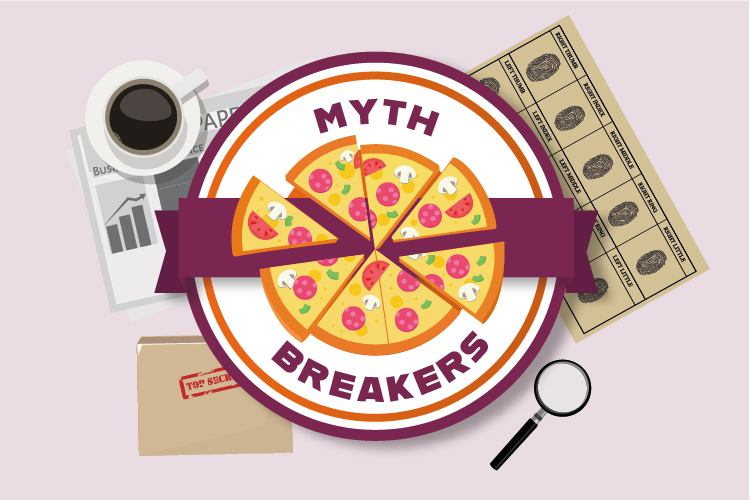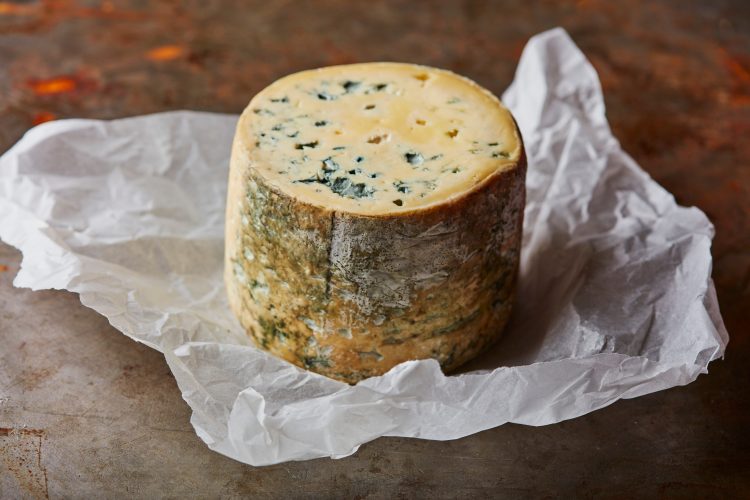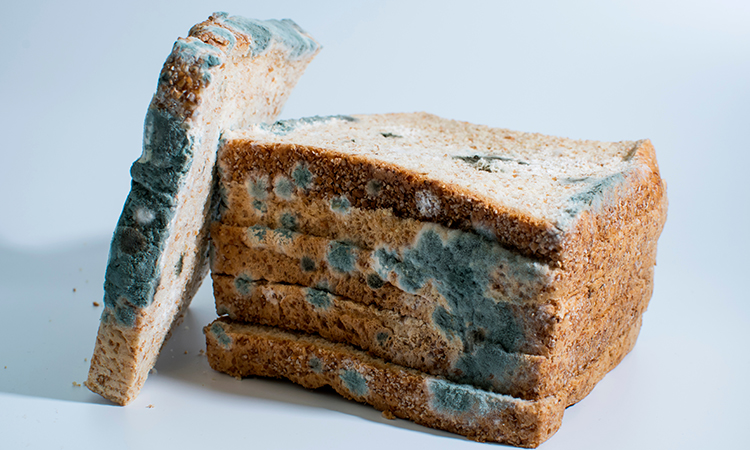Myth Breakers – Picking mould off bread is fine…right?
- Like
- Digg
- Del
- Tumblr
- VKontakte
- Buffer
- Love This
- Odnoklassniki
- Meneame
- Blogger
- Amazon
- Yahoo Mail
- Gmail
- AOL
- Newsvine
- HackerNews
- Evernote
- MySpace
- Mail.ru
- Viadeo
- Line
- Comments
- Yummly
- SMS
- Viber
- Telegram
- Subscribe
- Skype
- Facebook Messenger
- Kakao
- LiveJournal
- Yammer
- Edgar
- Fintel
- Mix
- Instapaper
- Copy Link
Posted: 14 May 2021 | Joshua Minchin (New Food) | No comments yet
New Food hears from food scientist Simon Dawson on his advice when it comes to mouldy food and potentially risky slices of toast.


We’ve all done it. Reached for that last slice of bread and realised a few blue spots of mould have made themselves at home, and quietly cut the affected areas off to put back the inevitable trip to the shops for another day.
It’s not just bread whose shelf-life this writer is guilty of extending a little too long; cheddar cheese (not a fungus-friendly cheese variety) has also faced the surgical mould removal procedure, as has the remnants of the margarine tub on occasion.
But just because a lot of us do it, doesn’t mean it’s risk-free..
Mycotoxins
Despite being completely natural, mould certainly does not look appealing. There surely aren’t many people out there who have knowingly eaten the kind of mould that grows on food once its been neglected too long, but the true problem is the mycotoxins mould can release once it begins to grow.
Mycotoxins are produced by fungi and can cause quite severe disease in humans, even death, depending on the amount consumed and the age and general health of the individual. Symptoms of mycotoxin consumption can include vomiting and diarrhoea.
Probably the biggest problem with mould is its ability to produce toxic compounds that are often carcinogenic and/or mutagenic – known collectively as ‘mycotoxins’. “Of these, aflatoxins are probably the most dangerous and have gained a lot of publicity over the years. Others include ochratoxins, vomitoxins, fumonisins and patulin,” explained Simon Dawson, who is a Senior Lecturer in Food Science and Technology at Cardiff Metropolitan University.
“All can have severe, even life-threatening symptoms upon ingestion if enough is consumed either in one sitting (aflatoxicosis) or over an extended period. Symptoms can vary from gastrointestinal pains and nausea to oesophageal and liver cancers, immune deficiencies, effects on foetal development and even death.”
This is not a small problem. Mycotoxin contamination has been estimated to affect 25 percent of the world’s crops, and efforts to mitigate the spread of these dangerous toxins cost the food industry heavily.
In addition, mycotoxins might even be responsible for one of US history’s darkest chapters and the inspiration behind Arthur Miller’s The Crucible. “Toxicologists have theorised that the Salem Witch Trials in 1692 were a result of the residents consuming contaminated grains with the mycotoxin, Ergot. Symptoms of the ‘bewitched’ residents included muscle spasms, psychosis and hallucinations, often progressed to gangrene, convulsions and death,” Dawson told New Food.
Is all mould bad for you?
Mould is a tricky customer. Whilst some varieties will produce the kind of toxins described above and make humans quite unwell if consumed, others have cured diseases (and given us some tasty cheeses!)…so are all moulds to be avoided?
“The difficulty is that not all moulds will produce one of these toxins, the moulds that do produce these toxins do not always do it, and in some circumstances altering the environment can either enhance or reduce the chances of these toxins forming,” said Dawson.
“Take the surface mould on cheese, for example. The main mould responsible here is a Penicillium species. In a cheese-making environment, this mould quickly stops the production of toxins and instead produces compounds that enhance flavour and textural development. However, mould development on cut surface cheese is not like this, and any toxins will keep forming.”


Mould can give us some tasty cheese, like this stilton, but it’s a very different story once it grows post-manufacture
But is de-moulded food safe to eat?
The debate on whether to eat bread once it has had the mould removed is a divisive one among consumers, but the experts are pretty unanimous in their verdict. While many of us will simply scrape off the offending area and continue with our slumbery walk to the toaster, the roots of the fungus you have just condemned to the bin can continue underneath the surface of soft food, such as bread, making the whole slice, unfortunately, inedible.
“What a lot of people don’t realise is that it isn’t just visible surface mould that can be a problem. Mould forms multicellular structures called hyphae which include thread-like invisible roots that penetrate food. Softer foods, such as breads and soft fruits will have much deeper roots than firmer foods such as hard cheese or dry-cured meats,” explained Dawson.
“Eating a visibly unblemished slide of bread, when there are clear signs of mould on that loaf, does not mean that slice is free from mould. Mould spores can also become airborne so opening a bag of mouldy bread, for example, can release these spores into the air – which can be inhaled and contaminate all nearby surfaces!”
But the rest of the loaf, which is unblemished, is surely fine? Not exactly, although there is room for a personal judgement call here if you are desperate for some toast. “As the roots can penetrate quite deep it is best to just avoid the contaminated loaf,” Dawson added.
“You can use your judgement here. If there is one tiny mould spot on an end slice of a full loaf, throwing away that full loaf is a little overkill, however, if the bread is riddled then do not even attempt to open the bag. Keep this sealed and put it straight into the bin.”


Loaves that look this are probably beyond saving…
Does this go for all mouldy foods?
Mould growth does not necessarily equate to a bin sentence for all foods, though there are certain types that require more caution than others. “Soft foods, such as breads, baked goods, soft fruits and vegetables, jams, soft meats, soft cheese, nuts and nut butters should be thrown away once contaminated,” said Dawson.
“This is because the fungus’ roots can penetrate quite deep and it isn’t worth risking consumption. Mycotoxins can be really dangerous to consume for humans and all animals. If you have any mouldy foods, do not feed these to your pets either!”
Yet Dawson did provide some vindication for the ‘cut around the mould and carry on’ method – but only on very specific food types. “For firmer foods, such as hard cheeses, some firm vegetables (eg, carrots, cabbage) and dry-cured meats you can cut around the mould,” he said. “Don’t touch the mould – cut about two to three centimetres around it, discard the mouldy piece, and the rest of the food item should be fine.”
The conclusion is quite clear then. A mouldy slice of bread really should just be discarded – any salvage attempts at that stage are sadly too late. The US Department for Agriculture’s Food Safety and Inspection Service has put together a useful table with advice on how to handle different food types once they are contaminated with mould, which is helpful in preventing unnecessary food waste (as well as avoiding risk).
Related topics
Contaminants, Food Safety, Lab techniques, Mycotoxins, Research & development, The consumer
Related organisations
Cardiff Metropolitan University, United States Department of Agriculture (USDA)







